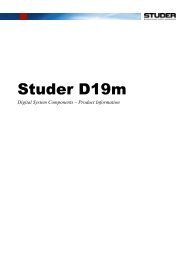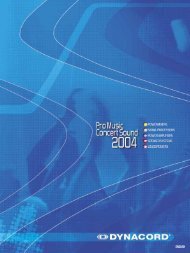You also want an ePaper? Increase the reach of your titles
YUMPU automatically turns print PDFs into web optimized ePapers that Google loves.
<strong>ICEpower</strong> <strong>ASP</strong>-<strong>Series</strong> <strong>Designers</strong> <strong>Manual</strong>, Professional Analog Amplifier w/ <strong>ICEpower</strong> Supply Version 1.4<br />
Shielding and Grounding of Audio Signals<br />
To eliminate hum and noise due to ground loops and insufficient cable shielding, schematics showing our<br />
recommended ground and shielding philosophy can be found in Appendix 1.<br />
When dealing with switching amplifiers, unwanted frequency components at the output of the amplifier due to<br />
different switching frequencies will occur. These signals (spurious) must be kept at a minimum to avoid<br />
audibility. Avoiding spurious output requires attention to cabling and grounding.<br />
<strong>ICEpower</strong> recommends two different basic grounding schemes<br />
• Star ground placed at the output of the power supply<br />
• Using the low impedance aluminum back plate as a ground plane<br />
Both grounding schemes work flawlessly, but with slightly lower spurious when using the back plate as a ground<br />
plane. Spurious output levels below –120dB related to full power are achievable.<br />
In the case of two hanger modules being placed in close proximity to each other, it might be necessary to place<br />
a grounded aluminum shield between the modules to achieve lowest possible spurious levels.<br />
The analog audio signal input interface is intended for balanced signal routing. However, by shorting the<br />
negative signal input to ground a single-ended audio input interface can be derived. Short pin 1 and pin 3 at the<br />
input XLR connector as shown in Appendix 1.<br />
EMC Management<br />
<strong>ICEpower</strong> amplifiers and power supplies utilize the latest switching technology to offer intelligent, compact and<br />
efficient audio power conversion systems. However, operating with fast switching signals unwanted high<br />
frequency noise is generated, which may exceed the standardized EMI limits if the necessary high frequency<br />
design precautions are not taken.<br />
The <strong>ICEpower</strong> <strong>ASP</strong>-series has been pre-approved according to the following EMC standards:<br />
• EN55103-1<br />
• EN55103-2<br />
• FCC part 15b Class A<br />
The device under test is mounted in a shielding box (see appendix 2) and loaded with a resistive load. The test<br />
signal is pink noise corresponding to 1/8 th of the rated power dissipated in the load.<br />
Even though the <strong>ICEpower</strong> modules themselves are pre-approved, it is necessary to approve the final product<br />
according to the applicable standards.<br />
Do’s and Don’ts<br />
Electromagnetic Interference (EMI) is emitted from any cable carrying RF currents. This chapter describes some<br />
guidelines to help reduce EMI in an <strong>ICEpower</strong> system.<br />
Page 5 of 46




